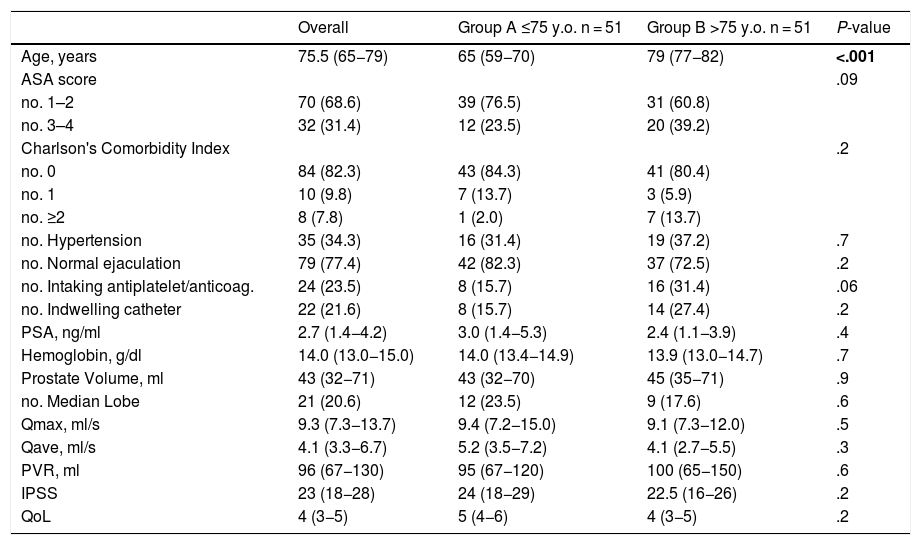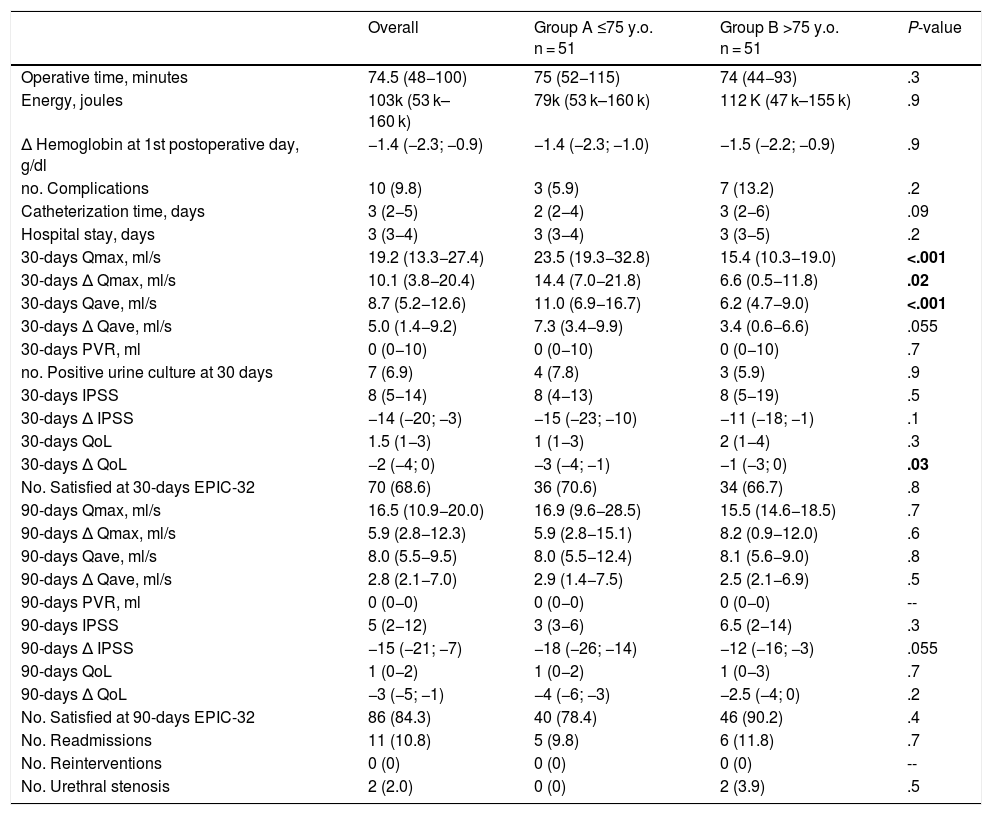To evaluate if thulium laser vapoenucleation of the prostate (ThuVEP) is equally safe and effective in a selected cohort of elderly patients when compared to “younger” patients.
Materials and MethodsWe performed a retrospective analysis of consecutive patients who underwent ThuVEP between September 2018 and February 2020. After application of the inclusion/exclusion criteria, patients were stratified according to the 75 years-old cut-off point suggested by the WHO. Group A included patients ≤75 years-old; Group B included patients >75 years-old.
Preoperative assessment included urological consultation, prostate specific antigen (PSA), International Prostate Symptom Score (IPSS) and quality of life index, transrectal ultrasound to estimate prostate volume (PVol), and uroflowmetry to assess preoperative Qmax, Qave and post-void residual volume (PVR). Perioperative and postoperative data were analyzed during 3-month follow-up.
ResultsAfter propensity-score analysis, 51 versus 51 patients were 1:1 matched according to PVol, PSA, Qmax, IPSS and QoL. Patients were comparable at baseline excluding age (65 (IQR 59−70) versus 79 (IQR 77−82) years, Group A versus B, respectively, P-value <.001).
No differences were found in terms of hemoglobin drop, complications rate, catheterization time and length of hospital stay. Group A (younger) patients had more significant improvement in 30-days absolute Qmax, Qave and ΔQmax. At 90-days follow-up, the differences between the groups disappeared.
Within the 90-days follow-up, no significant differences were found in the readmission rate, with no need of reinterventions.
ConclusionsIn our hands, even in elderly patients affected by BPH, ThuVEP appears to be a safe and effective treatment option.
Evaluar si la vapoenucleación prostática con laser tulio (TuLEP) es igualmente segura y efectiva en una cohorte seleccionada de pacientes ancianos en comparación con pacientes “más jóvenes”.
Materiales y MétodosSe realizó un análisis retrospectivo de los pacientes consecutivos que se sometieron a TuLEP entre septiembre de 2018 y febrero de 2020. Tras aplicar los criterios de inclusión/exclusión, los pacientes se estratificaron según el punto de corte de 75 años sugerido por la OMS: el grupo A incluyó a los pacientes <75 años; el grupo B incluyó a los pacientes >75 años.
La evaluación preoperatoria incluyó una consulta con el urólogo, el valor del antígeno prostático específico (PSA), el International Prostate Symptom Score (IPSS) y QoL, ecografía transrectal para estimar el volumen prostático (PVol) y uroflujometría para evaluar los valores preoperatorios de Qmax y Qave y el volumen residual postmiccional (PVR). Se analizaron los datos perioperatorios y postoperatorios con un seguimiento de 3 meses.
ResultadosTras el análisis de puntuación de propensión, 51 pacientes fueron emparejados 1:1 frente a otros 51 con base en PVol, PSA, Qmax, IPSS y QoL. Los pacientes eran comparables al inicio excluyendo la edad 65 (IQR 59−70) versus 79 (IQR 77−82) años, Grupo A versus grupo B, respectivamente, valor P < ,001).
No se encontraron diferencias en cuanto al descenso de la hemoglobina, la tasa de complicaciones, el tiempo de cateterismo y la duración de la estancia hospitalaria. Los pacientes del grupo A (más jóvenes) experimentaron una mejora significativamente mayor en cuanto al valor absoluto de Qmax, Qave y ΔQmax a los 30 días. A los 90 días de seguimiento, las diferencias entre los grupos desaparecieron.
Durante los 90 días de seguimiento, no se encontraron diferencias significativas en la tasa de reingreso, ni se requirieron reintervenciones.
ConclusionesEn nuestras manos, incluso en pacientes ancianos afectados por HBP, la TuLEP parece ser una opción de tratamiento segura y efectiva.










